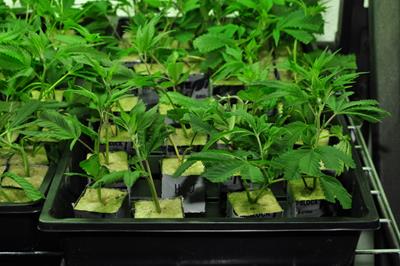
Saturday January 2, 2016
 Growing
Growing
Growing your own marijuana is very rewarding, but also quite time-consuming. Depending on the strain, the total time it takes to grow cannabis from seed to harvest could be anywhere from eight weeks to more than seven months (which doesn’t even include curing time).
Fortunately, there is a way to cut down on the total grow time while maintaining a stockpile of marijuana plants: cannabis clones.
Should I use clones to grow marijuana?
There are many reasons to grow marijuana from clones including a reduced grow time, an indefinite grow cycle and the ability to pre-select female plants. This is especially true for indoor grow rooms that allow for a better controlled environment during all stages of growth.
-
Reduced Grow Time
A clone should only take a week or two to take root after being removed from the mother. From this point, the clone could continue in the vegetative state until a desired size is reached or be moved directly into its flower phase knocking a few good weeks off of a grow cycle.
-
An Indefinite Supply
The best buds are seed-free which makes it difficult to keep a constant supply of seeds for the next grow cycle. By taking cuttings off of mother plants, you can keep a constant supply of the same strains that you already know you’ll love.
-
Pre-Selected Female Plants
A clone is an exact genetic copy of its parent. By taking a clone from a female plant, you’re ensuring that the next generation will be female, too. You can also use cuttings to pre-determine the gender of a plant before introducing the whole thing to a 12/12 light cycle.
How to Take a Clone from Marijuana
Pruning is a necessary part of maintaining a healthy cannabis plant and will result in bushier plants and fuller buds. You can take clones during the pruning process by following a few simple steps.
-
Gather your materials
The supplies needed to clone a healthy cannabis plant include a sterile blade, rooting agent, a grow medium (like rockwool), a grow tray with a vented hood, distilled water and a mother plant.
-
Prepare your grow medium
Rockwool, the most common grow medium has a high pH level and must therefore be treated by first soaking it in a water solution with a pH value of 5.5 (you can adjust this using a digital pH meter and pH adjuster fluid).
After soaking, remove the rock wool and transfer into a mild vegetative nutrient solution with an adjusted pH at around 6.0. When you’re ready to begin the cloning process, transfer the cubes to the grow tray and set aside.
-
Choose your cutting
Use your sterile blade to cut a 4- to 6-inch branch from the mother plant along the stem at a 45 degree angle then dip the cutting into the rooting agent, a hormone-based gel that stimulates root growth. Place the stem of the cutting firmly into the growing medium and repeat (remember to take extra clones in case a few don’t survive).
-
Set up your clones
Clones love moisture, but they need to breathe, too. Make sure they’ve got what they need by misting the leaves then securing a dome top in place. Pay close attention to the moisture content (make sure they’re not swimming) and vent when necessary.
Place your clone tray under grow lights (CFLs work well) and monitor carefully over the next few days. As soon as roots appear, you can transfer the cutting to a soil or hydroponic system.

Clone Trays
Cannabis is a plant that keeps on giving. Help continue the giving by taking clones from your favorite marijuana plants.
Do you have a question for PotGuide? Ask away.
Photo Credit: PotGuide.com







